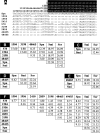Molecular characterization of disease-associated streptococci of the mitis group that are optochin susceptible
- PMID: 16971639
- PMCID: PMC1698351
- DOI: 10.1128/JCM.01137-06
Molecular characterization of disease-associated streptococci of the mitis group that are optochin susceptible
Abstract
Eight optochin-susceptible (Opt(s)) alpha-hemolytic (viridans) streptococcus isolates were characterized at the molecular level. These isolates showed phenotypic characteristics typical of both viridans streptococci and Streptococcus pneumoniae. Comparison of the sequence of housekeeping genes from these isolates with those of S. pneumoniae, Streptococcus mitis, Streptococcus oralis, and Streptococcus pseudopneumoniae suggested that the Opt(s) isolates corresponded to streptococci of the mitis group. Besides, the Opt(s) streptococci were negative by a Gen-Probe AccuProbe pneumococcus test and hybridized with specific pneumococcal probes (lytA and ply) but also with ant, a gene not present in most S. pneumoniae strains. Moreover, the isolates were insoluble in 1% sodium deoxycholate but completely dissolved in 0.1% deoxycholate. Sequence analysis of the lytA gene revealed that the Opt(s) streptococci carried lytA alleles characteristic of those present in nonpneumococcal streptococci of the mitis group. The determination of the partial nucleotide sequence embracing the atp operon encoding the F(o)F(1) H(+)-ATPase indicated that the optochin susceptibility of the isolates was due to the acquisition of atpC, atpA, and part of atpB from S. pneumoniae by horizontal gene transfer.
Figures




Similar articles
-
Genetic characterization of optochin-susceptible viridans group streptococci.Antimicrob Agents Chemother. 2003 Oct;47(10):3187-94. doi: 10.1128/AAC.47.10.3187-3194.2003. Antimicrob Agents Chemother. 2003. PMID: 14506029 Free PMC article.
-
Characterization of recombinant fluoroquinolone-resistant pneumococcus-like isolates.Antimicrob Agents Chemother. 2013 Jan;57(1):254-60. doi: 10.1128/AAC.01357-12. Epub 2012 Oct 31. Antimicrob Agents Chemother. 2013. PMID: 23114769 Free PMC article.
-
Clinical optochin resistant Streptococcus pneumoniae and Streptococcus pseudopneumoniae strains in Tunisia.J Infect Dev Ctries. 2021 May 31;15(5):672-677. doi: 10.3855/jidc.13106. J Infect Dev Ctries. 2021. PMID: 34106891
-
Identification of Streptococcus pneumoniae and other Mitis streptococci: importance of molecular methods.Eur J Clin Microbiol Infect Dis. 2020 Dec;39(12):2247-2256. doi: 10.1007/s10096-020-03991-9. Epub 2020 Jul 24. Eur J Clin Microbiol Infect Dis. 2020. PMID: 32710352 Free PMC article. Review.
-
Versatility of choline metabolism and choline-binding proteins in Streptococcus pneumoniae and commensal streptococci.FEMS Microbiol Rev. 2009 May;33(3):572-86. doi: 10.1111/j.1574-6976.2009.00172.x. FEMS Microbiol Rev. 2009. PMID: 19396958 Review.
Cited by
-
Relationships among streptococci from the mitis group, misidentified as Streptococcus pneumoniae.Eur J Clin Microbiol Infect Dis. 2020 Oct;39(10):1865-1878. doi: 10.1007/s10096-020-03916-6. Epub 2020 May 14. Eur J Clin Microbiol Infect Dis. 2020. PMID: 32409955 Free PMC article.
-
Identification of clinical Streptococcus pneumoniae isolates among other alpha and nonhemolytic streptococci by use of the Vitek MS matrix-assisted laser desorption ionization-time of flight mass spectrometry system.J Clin Microbiol. 2013 Jun;51(6):1861-7. doi: 10.1128/JCM.03069-12. Epub 2013 Apr 10. J Clin Microbiol. 2013. PMID: 23576536 Free PMC article.
-
Co-Transcriptomes of Initial Interactions In Vitro between Streptococcus Pneumoniae and Human Pleural Mesothelial Cells.PLoS One. 2015 Nov 13;10(11):e0142773. doi: 10.1371/journal.pone.0142773. eCollection 2015. PLoS One. 2015. PMID: 26566142 Free PMC article.
-
Novel molecular method for identification of Streptococcus pneumoniae applicable to clinical microbiology and 16S rRNA sequence-based microbiome studies.J Clin Microbiol. 2012 Jun;50(6):1968-73. doi: 10.1128/JCM.00365-12. Epub 2012 Mar 21. J Clin Microbiol. 2012. PMID: 22442329 Free PMC article.
-
Streptococcus mitis as a New Emerging Pathogen in Pediatric Age: Case Report and Systematic Review.Antibiotics (Basel). 2023 Jul 23;12(7):1222. doi: 10.3390/antibiotics12071222. Antibiotics (Basel). 2023. PMID: 37508318 Free PMC article. Review.
References
-
- Abrahams, J. P., A. G. W. Leslie, and J. E. Walker. 1994. Structure at 2.8 Å resolution of F1-ATPase from bovine heart mitochondria. Nature 370:621-628. - PubMed
-
- Arbique, J. C., C. Poyart, P. Trieu-Cuot, G. Quesne, M. da Glória S. Carvalho, A. G. Steigerwalt, R. E. Morey, D. Jackson, R. J. Davidson, and R. R. Facklam. 2004. Accuracy of phenotypic and genotypic testing for identification of Streptococcus pneumoniae and description of Streptococcus pseudopneumoniae sp. nov. J. Clin. Microbiol. 42:4686-4696. - PMC - PubMed
-
- Borek, A. P., D. C. Dressel, J. Hussong, and L. R. Peterson. 1997. Evolving clinical problems with Streptococcus pneumoniae: increasing resistance to antimicrobial agents, and failure of traditional optochin identification in Chicago, Illinois, between 1993 and 1996. Diagn. Microbiol. Infect. Dis. 29:209-214. - PubMed
Publication types
MeSH terms
Substances
LinkOut - more resources
Full Text Sources
Molecular Biology Databases

